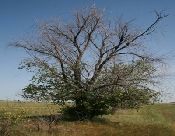|
Evaluating the desertification risk assessment tool with local experimental results |
 |
|
Author: Victor Jetten
Introduction
The Karapinar area is the most arid part of Anatolia in Turkey, which suffers from wind erosion due to unfavorable soil and climatic conditions. Also the area knows intensive use of ground water resources for irrigation. Earlier ground water well measurement showed that annual drop reaches 8-10 m. Farmers mostly prefer cereals, maize and sugar beet as irrigated crop types. Ploughing often results in fine particles that are removed by the wind. Direct drilling has already been introduced as an alternative. An experiment was carried out to test the effect of minimum tillage and stubble on wheat (Ekiz bread wheat) without irrigation. Sediment moved by wind erosion itself is very difficult to measure so the experiment concentrated on the suitability of these tillage forms.
Desertification indices
The area is mainly subject to wind erosion, which is not a factor in the risk assessment tool. The desertification index for water stress is evaluated. This is because the crops are irrigated and heavy (over) exploitation of groundwater is common. Together with a low rainfall and marked dry season this results in a high risk of water stress, in accordance with the experiments.
However the use of minimum tillage has no effect on water stress so the technology cannot be further evaluated. The experiment showed that it is possible to have a reasonable yield with minimum tillage without irrigation. If we assume this would cause a gradual change in groundwater exploitation until there is only local overexploitation, the water stress risk will be reduced to moderate.
 |
Wheat production under circumstances of groundwater exploitation |
Conclusions
Wind erosion cannot be evaluated with the tool. Water stress, although correctly seen as having a high risk, is not influenced by tillage practices.If the minimum tillage causes the crop to have acceptable yield with rainfall only without the need for groundwater irrigation, this would decrease the water stress risk to moderate.
|




